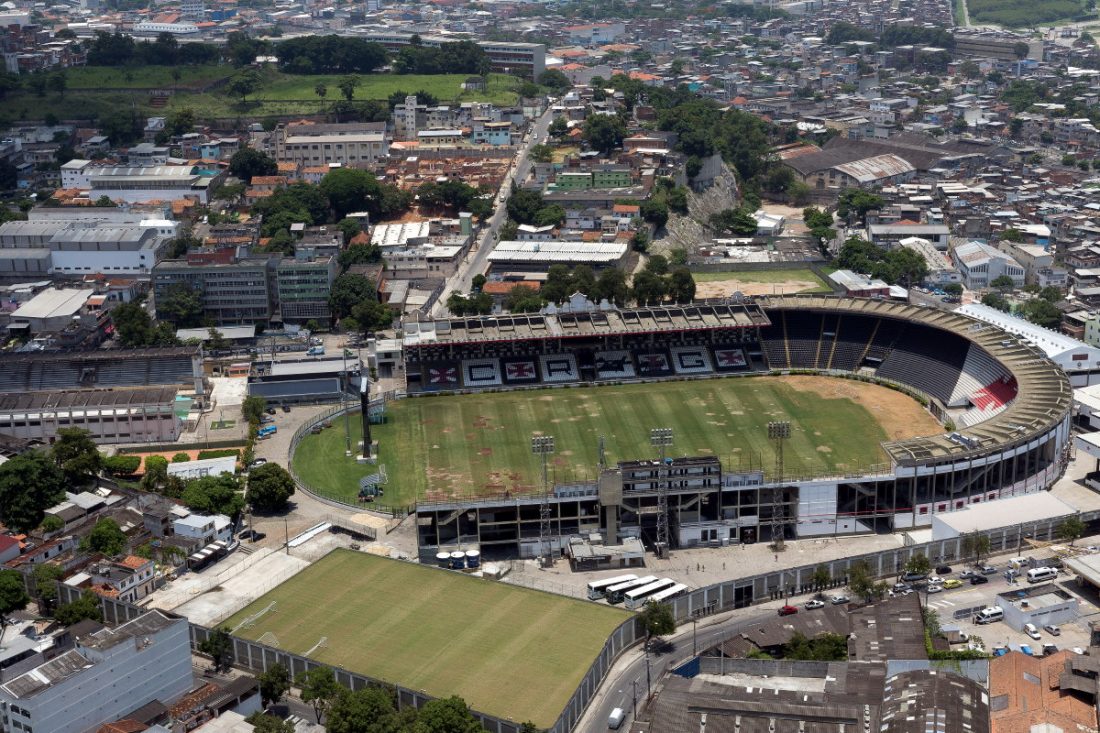
Key facts
Club: CR Vasco da Gama | Opening: 1927 | Capacity: 24,584 seats
History and description
São Januário, nicknamed Gigante da Colina, opened on 21 April 1927 with a match between Vasco da Gama and Santos (5-3). The stadium was at that time the largest in South America, and though it lost that status quickly, it remained the largest in Brazil until the opening of Pacaembu in 1940.
In the 1930s and 1940s, São Januário regularly hosted the Brazilian national team and it was one of the two playing venues at the 1949 Copa América. However, since the completion of Maracaña in 1950 the stadium has had to settle with only two international friendlies in the late 1980s and early 1990s.
The facade of the main stand is listed as national heritage. In 2007 a statue of Romario was erected right behind the goal in which he scored his 1000th goal ever.
The stadium has hardly changed over the years, though it recently underwent a refurbishment of its interior, VIP areas, and seating areas.
How to get to Sao Januario
São Januário is located in the north of Rio de Janeiro, about 7 kilometres north-west from downtown Rio de Janeiro, 5 kilometres north-west from the central rail station, and 3 kilometres from the Rodoviária Novo Rio long-distance bus station.
It’s easiest to take a taxi to the stadium, but otherwise there are various bus services that can bring you there.
Bus 473 gets you from Copacabana directly to the stadium. Get on the bus at the Rua Tonelera. The stadium is at the end of the line.
Bus 472 also passes right in front of the stadium. You can board this bus in downtown (Av Pres Vargas), Flamengo (Praia do Flamengo), or at the northern edge of Copacabana beach.
From Ipanema you can catch bus 474, which also passes through Copacabana (Av Ns de Copacabana), Flamengo, and downtown. The bus stops a 5-minute walk away from the stadium (follow the Rua São Januário north).
Address: Rua General Almério de Moura 131, Bairro Vasco da Gama, Rio de Janeiro
Vasco da Gama Tickets
Tickets for Vasco da Gama matches can be bought online, at the ticket office at São Januário, or at any of the other sales points, among which the club office in Lagoa and one of multiple club shops, including the one at Rua Figueiredo de Magalhães 286 in Copacabana.
Tickets tend to go on sale from a few days before the match.
Tickets can also be bought at the ticket windows of the stadium before the start of the match, though the local derbies may sell out.
Ticket prices will range from R$30.00 to R$100.00 for most opponents, but can be increased to between R$50.00 and R$150.00 for high-profile opponents.
Sao Januario Stadium Tours
Vasco da Gama offers guided stadium tours that include access to the trophy room, VIP areas, and stadium chapel.
Tours run multiple times a day Mondays to Saturdays, with English-language tours on Saturdays. Check the official website for current schedules.
The tours costs R$40.00. Email tour@crvascodagama.com for bookings and more information.
Useful Internet links
Crvascodagama.com – Official website of CR Vasco da Gama.
Rioguiaoficial.com.br – Official guide to Rio de Janeiro.
Vadeonibus.com.br – Public transport journey planner.
Photo credits: Diego Baravelli
2 comments
Went there today to watch Vasco against Sao Paulo. Amazing stadium and even better fans. The best atmosphere i experience during my 4 games in Brazil. I took taxi from Maracana for 20 reals and the same way i came back. Taxis are so cheap there is No point going by bus especially if you do not know the area. Tickets are sold outside the stadium by fans as well as in the ticket offices.
Going to São Januario stadium these days is a trip down brazilian and carioca football memory lane, being the last standing stadium in Rio that remain having concrete terraces with no seats in most parts of the stadium, which definetaly favor more fanatic supporters and a better and more tradiitional atmosphere. Vasco is a traditional club, widely supported by the portugueese descendents in Rio alongside many others. Vasco has a lot more of a blue collar working class feel than the other big 3 Rio clubs. A definate experience worthwhile for football fans visiting Rio, the only downpoint being not so good transportation to the site. The area is also surrounded by a favela in one end of the grounds, yet that normally does not affect travellers.